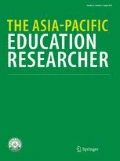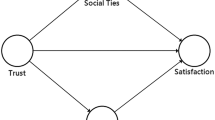Abstract
Online child-care resources help parents to understand useful parenting knowledge and skills, and play effective roles in raising young children. This study focused on parents’ attitudes toward online parenting resources regarding their perceived usefulness and satisfaction; it also examined the multiple mediated effects of their attitudes toward liking and interacting online when accessing and engaging with child-care resources. A survey was conducted in Taiwan; the questionnaire was composed of four factors: perceived usefulness, satisfaction, liking, and online interaction, and tested for indirect effects with the mediated variables. The findings showed what parents of young children considered positive about the usefulness of online parenting resources and that they employed the online technology to collect and advance their knowledge and abilities for raising young children. They liked interesting parenting resources and preferred interacting with others about child-care practices. Finally, the researchers discussed the results and traced the implications derived from this study.

Similar content being viewed by others
References
Alothman, M., Robertson, J., & Michaelson, G. (2017). Computer usage and attitudes among Saudi Arabian undergraduate students. Computers & Education,110, 127–142.
Alzahrani, A. I., Mahmud, I., Ramayah, T., Alfarraj, O., & Alalwan, N. (2017). Modelling digital library success using the DeLone and McLean information system success model. Journal of Librarianship and Information Science. https://doi.org/10.1177/0961000617726123
Baker, S., Sanders, M. R., & Morawska, A. (2017). Who uses online parenting support? A cross-sectional survey exploring Australian parents' internet use for parenting. Journal of Child and Family Studies,26(3), 916–927.
Bartholomew, M. K., Schoppe-Sullivan, S. J., Glassman, M., Dush, C. M. K., & Sullivan, J. M. (2012). New parents' facebook use at the transition to parenthood. Family Relations,61(3), 455–469.
Benesh, A. S., & Cui, M. (2017). Foster parent training programmes for foster youth: A content review. Child & Family Social Work,22(1), 548–559.
Burstein, M. D., Robinson, J. O., Hilsenbeck, S. G., McGuire, A. L., & Lau, C. C. (2014). Pediatric data sharing in genomic research: Attitudes and preferences of parents. Pediatrics,133(4), 690–697.
Chang, F. C., Chiu, C. H., Chen, P. H., Miao, N. F., Lee, C. M., Chiang, J. T., et al. (2015). Relationship between parental and adolescent ehealth literacy and online health information seeking in Taiwan. Cyberpsychology Behavior and Social Networking,18(10), 618–624.
Chou, C., & Lee, Y. H. (2017). The moderating effects of internet parenting styles on the relationship between Internet parenting behavior, Internet expectancy, and Internet addiction tendency. The Asia-Pacific Education Researcher,26(3–4), 137–146.
Clarke, S. A., Calam, R., Morawska, A., & Sanders, M. (2014). Developing web-based Triple P "Positive Parenting Programme' for families of children with asthma. Child Care Health and Development,40(4), 492–497.
Coyne, S. M., McDaniel, B. T., & Stockdale, L. A. (2017). "Do you dare to compare?" Associations between maternal social comparisons on social networking sites and parenting, mental health, and romantic relationship outcomes. Computers in Human Behavior,70, 335–340.
Davis, F. D. (1989). Perceived usefulness, perceived ease of use, and user acceptance of information technology. MIS Quarterly,13, 319–340.
De Rouck, S., & Leys, M. (2013). Illness trajectory and Internet as a health information and communication channel used by parents of infants admitted to a neonatal intensive care unit. Journal of Advanced Nursing,69(7), 1489–1499.
DeLone, W. H., & McLean, E. R. (1992). Information systems success: The quest for the dependent variable. Information systems research,3(1), 60–95.
Delone, W. H., & McLean, E. R. (2003). The DeLone and McLean model of information systems success: A ten-year update. Journal of management information systems,19(4), 9–30.
DeLone, W. H., & McLean, E. R. (2016). Information systems success measurement. Foundations and Trends® in Information Systems, 2(1), 1–116.
Dittman, C. K., Farruggia, S. P., Palmer, M. L., Sanders, M. R., & Keown, L. J. (2014). Predicting success in an online parenting intervention: The role of child, parent, and family factors. Journal of Family Psychology,28(2), 236–243.
Ergun, E., & Avci, U. (2018). Knowledge sharing self-efficacy, motivation and sense of community as predictors of knowledge receiving and giving behaviors. Educational Technology & Society,21(3), 60–73.
Flittner O’Grady, A. E., MacDermid Wadsworth, S., Willerton, E., Cardin, J. F., Topp, D., Mustillo, S., et al. (2015). Help seeking by parents in military families on behalf of their young children. Psychological Services,12(3), 231–240.
Fowler, C., Wu, C., & Lam, W. (2014). Participatory action research: Involving students in parent education. Nurse Education in Practice,14(1), 76–81.
Goh, D., & Chi, J. X. (2017). Central or peripheral? Information elaboration cues on childhood vaccination in an online parenting forum. Computers in Human Behavior,69, 181–188.
Hair, J. F., Jr., Hult, G. T. M., Ringle, C., & Sarstedt, M. (2013). A primer on partial least squares structural equation modeling (PLS-SEM). Thousand Oaks: Sage.
Haslam, D. M., Tee, A., & Baker, S. (2017). The use of social media as a mechanism of social support in parents. Journal of Child and Family Studies,26(7), 2026–2037.
Hsu, M. W. (2016). An analysis of intention to use in innovative product development model through TAM model. Eurasia Journal of Mathematics Science and Technology Education,12(3), 487–501.
Jang, J., Hessel, H., & Dworkin, J. (2017). Parent ICT use, social capital, and parenting efficacy. Computers in Human Behavior,71, 395–401.
Jones, Q., Ravid, G., & Rafaeli, S. (2004). Information overload and the message dynamics of online interaction spaces: A theoretical model and empirical exploration. Information Systems Research,15(2), 194–210.
Kao, C., & Chien, H. (2017). Web-searching to learn: The role of Internet self-efficacy in pre-school educators’ conceptions and approaches. Eurasia Journal of Mathematics Science & Technology Education,13(6), 2039–2056.
Koohang, A. A. (1989). A study of attitudes toward computers: Anxiety, confidence, liking, and perception of usefulness. Journal of Research on Computing in education,22(2), 137–150.
Lee, C. M., Smith, P. B., Stern, S. B., Piché, G., Feldgaier, S., Ateah, C., et al. (2014a). The international parenting survey-Canada: Exploring access to parenting services. Canadian Psychology,55(2), 110–116.
Lee, Y. J., Boden-Albala, B., Larson, E., Wilcox, A., & Bakken, S. (2014b). Online health information seeking behaviors of Hispanics in New York City: A community-based cross-sectional study. Journal of Medical Internet Research,16(7), e176.
Liu, E. Z. F., Lee, C. Y., & Chen, J. H. (2013). Developing a new computer game attitude scale for Taiwanese early adolescents. Educational Technology & Society,16(1), 183–193.
Liu, H. X., Lin, C. H., Zhang, D. B., & Zheng, B. B. (2018). Chinese language teachers' perceptions of technology and instructional use of technology: A path analysis. Journal of Educational Computing Research,56(3), 396–414.
Liu, I. F., Chen, M. C., Sun, Y. S., Wible, D., & Kuo, C. H. (2010). Extending the TAM model to explore the factors that affect intention to use an online learning community. Computers & Education,54(2), 600–610.
Loyd, B. H., & Gressard, C. (1984). Reliability and factorial validity of computer attitude scales. Educational and Psychological Measurement,44(2), 501–505.
MacKinnon, D. P. (2008). Introduction to Statistical Mediation Analysis. Mahwah: Erlbaum.
McLean, K., Edwards, S., & Morris, H. (2017). Community playgroup social media and parental learning about young children's play. Computers & Education,115, 201–210.
Med, Y. H., & Dworkin, J. (2015). Cyber dads: What are fathers doing online? Fathering,13(3), 219–230.
Mitchell, S. J., Godoy, L., Shabazz, K., & Horn, I. B. (2014). Internet and mobile technology use among urban African American parents: Survey study of a clinical population. Journal of Medical Internet Research,16(1), e9.
Niela-Vilén, H., Axelin, A., Salanterä, S., & Melender, H. L. (2014). Internet-based peer support for parents: A systematic integrative review. International Journal of Nursing Studies,51(11), 1524–1537.
Nieuwboer, C. C., Fukkink, R. G., & Hermanns, J. A. (2014). Practitioner response to parental need in email consultation: How do they match? A content analysis. Child & Youth Care Forum,43(5), 553–567.
Nieuwboer, C. C., Fukkink, R. G., & Hermanns, J. M. A. (2017). Analysing empowerment-oriented email consultation for parents: Development of the guiding the empowerment process model. Child & Family Social Work,22(S3), 61–71.
Oprescu, F., Campo, S., Lowe, J., Andsager, J., & Morcuende, J. A. (2013). Online information exchanges for parents of children with a rare health condition: Key findings from an online support community. Journal of Medical Internet Research,15(1), e16.
Park, E., Kim, H., & Steinhoff, A. (2016). Health-related Internet use by informal caregivers of children and adolescents: An integrative literature review. Journal of Medical Internet Research,18(3), e57.
Picón, A., Castro, I., & Roldán, J. L. (2014). The relationship between satisfaction and loyalty: A mediator analysis. Journal of Business Research,67(5), 746–751.
Preacher, K. J., & Hayes, A. F. (2008). Asymptotic and resampling strategies for assessing and comparing indirect effects in multiple mediator models. Behavior Research Methods,40(3), 879–891.
Ringle, C. M., Wende, S., & Will, A. (2005). SmartPLS 2.0 (beta). https://www.smartpls.de. Hamburg: SmartPLS.
Rudd, B. N., Holtzworth-Munroe, A., Reyome, J. G., Applegate, A. G., & D'Onofrio, B. M. (2015). Randomized control trial: Online parent program and waiting period for unmarried parents in title IV-D court. Journal of Family Psychology,29(5), 679–686.
Sánchez-Prieto, J. C., Olmos-Migueláñez, S., & García-Peñalvo, F. J. (2017). MLearning and pre-service teachers: An assessment of the behavioral intention using an expanded TAM model. Computers in Human Behavior,72, 644–654.
Symons, D. K., Adams, S., & Smith, K. H. (2016). Adult attachment style and caregiver attitudes after raising a virtual child. Journal of Social and Personal Relationships,33(8), 1054–1069.
Umek, L., Aristovnik, A., Tomaževič, N., & Keržič, D. (2015). Analysis of selected aspects of students’ performance and satisfaction in a moodle-based e-learning system environment. Eurasia Journal of Mathematics, Science & Technology Education,11(6), 1495–1505.
Vereecken, C., Covents, M., Maes, L., & Moyson, T. (2013). Formative evaluation of the feedback component of children's and adolescents' nutrition assessment and advice on the web (canaa-w) among parents of schoolchildren. Public Health Nutrition,16(1), 15–26.
Walker, S., & Rudi, J. (2014). Parenting across the social ecology facilitated by information and communications technology: Implications for research and educational design. Journal of Human Sciences and Extension,2(2), 15–32.
Walsh, A. M., Hamilton, K., White, K. M., & Hyde, M. K. (2015). Use of online health information to manage children’s health care: A prospective study investigating parental decisions. BMC Health Services Research,15(1), e1.
Wetzels, M., Odekerken-Schroder, G., & van Oppen, C. (2009). Using PLS path modeling for assessing hierarchical construct models: Guidelines and empirical illustration. MIS Quarterly,33(1), 177–196.
Wright, K. B., Rosenberg, J., Egbert, N., Ploeger, N. A., Bernard, D. R., & King, S. (2013). Communication competence, social support, and depression among college students: A model of facebook and face-to-face support network influence. Journal of Health Communication,18(1), 41–57.
Yang, X. M., Song, S. Q., Zhao, X. S., & Yu, S. Q. (2018). Understanding user behavioral patterns in open knowledge communities. Interactive Learning Environments,26(2), 245–255.
Yoong, S. L., Williams, C. M., Finch, M., Wyse, R., Jones, J., Freund, M., et al. (2015). Childcare service centers’ preferences and intentions to use a web-based program to implement healthy eating and physical activity policies and practices: A cross-sectional study. Journal of Medical Internet Research,17(5), e108.
Zhao, L., Lu, Y. B., Wang, B., & Huang, W. N. (2011). What makes them happy and curious online? An empirical study on high school students' internet use from a self-determination theory perspective. Computers & Education,56(2), 346–356.
Zhao, X. M., & Basnyat, I. (2018). Online social support for "Danqin Mama": A case study of parenting discussion forum for unwed single mothers in China. Computers in Human Behavior,80, 12–21.
Author information
Authors and Affiliations
Corresponding author
Additional information
Publisher's Note
Springer Nature remains neutral with regard to jurisdictional claims in published maps and institutional affiliations.
Rights and permissions
About this article
Cite this article
Chang, IH., Chen, RS. The Impact of Perceived Usefulness on Satisfaction with Online Parenting Resources: The Mediating Effects of Liking and Online Interaction. Asia-Pacific Edu Res 29, 307–317 (2020). https://doi.org/10.1007/s40299-019-00484-y
Published:
Issue Date:
DOI: https://doi.org/10.1007/s40299-019-00484-y




